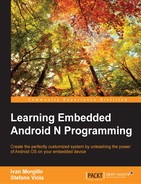So far, we have worked with Google devices, enjoying the Google open-source mindset. As advanced users, we frequently deal with devices that are not from Google or that are not even a smartphone. As a real-world example, we are going to use again a UDOO board: a single-board computer that supports Ubuntu or Android. For the time being, the most popular version of UDOO is the UDOO Quad and that's the version we are targeting.
As for every other device, the standard approach is to trust the manufacturer's website to obtain kernel source code and any useful documentation for the process: most of all, how to properly flash the new kernel to the system. When working with a custom kernel, the procedure is quite consolidated. You need the source code, the toolchain, a few configuration steps, and, maybe, some specific software package to be installed on to your host system. When it comes to flashing the kernel, every device can have a different procedure. This depends on how the system has been designed and which tools the manufacturing team provides. Google provides fastboot to flash our images to our devices. Other manufactures usually provide tools that are similar or that can do similar things with little effort.
The UDOO development team worked hard to make the UDOO board fully compatible with fastboot—instead of forcing you to adjust to their tools, they adjusted their device to work with the tools you already know. They tuned up the board's bootloader and you can now flash the boot.img using fastboot, like you were flashing a standard Google Android device.
To obtain the kernel, we just need to clone a git repository. With your trusted terminal, launch the following command:
$ git clone http://github.com/UDOOBoard/Kernel_Unico kernel
Once we have the kernel, we need to install a couple of software packages in our Ubuntu system to be able to work with it. With the following command, everything will be installed and put in place:
$ sudo apt-get install build-essential ncurses-dev u-boot-tools
Time to pick a toolchain! UDOO gives you a few possibilities—you can use the same toolchain you used for the Nexus 6 or you can use the one provided by the UDOO team itself. If you decide to use the UDOO official toolchain, you can download it with a couple of terminal commands. Be sure you have already installed curl. If not, just install it with the following command:
$ sudo apt-get install curl
Once you have curl, you can use the following command to download the toolchain:
$ curl http://download.udoo.org/files/crosscompiler/arm-fsl-linux-gnueabi.tar.gz | tar -xzf
Now, you have everything in place to launch the build process:
$ cd kernel $ make ARCH=arm UDOO_defconfig
The following is the output:

The previous screenshot shows the output of the configuration process. When the default .config file is ready, you can launch the build process with the following command:
$ make –j4 CROSS_COMPILE ../arm-fsl-linux-gnueabi/bin/arm-fsl-linux-gnueabi- ARCH=arm uImage modules
When the build process is over, you can find the kernel image in the arch folder:
$ arch/arm/boot/uImage
As for the Nexus 6, we can customize the UDOO kernel using menuconfig. From the kernel source folder, launch the following command:
$ make ARCH=arm menuconfig
The following screenshot shows the UDOO kernel configuration menu. It's very similar to the Nexus 6 configuration menu. We have the same combination of keys to navigate, select and deselect features, and so on:

Working with UDOO, the same warnings we had with the Nexus 6 apply here too—be careful while removing components from the kernel. Some of them are just meant to be there to support specific hardware, some of them, instead, are vital for the system to boot. As always, feel free to experiment, but be careful about gambling!
This kind of development device makes debugging the kernel a bit easier compared to a smartphone. UDOO, as with a lot of other embedded development boards, provides a serial connection that enables you to monitor the whole boot sequence. This comes in handy if you are going to develop a driver for some hardware and you want to integrate it into your kernel or even if you are simply playing around with some custom kernel configuration. Every kernel and boot-related message will be printed to the serial console, ready to be captured and analyzed.
The next screenshot shows the boot sequence for our UDOO Quad board:

As you can see, there is plenty of debugging information, from the board power-on to the Android system prompt.
